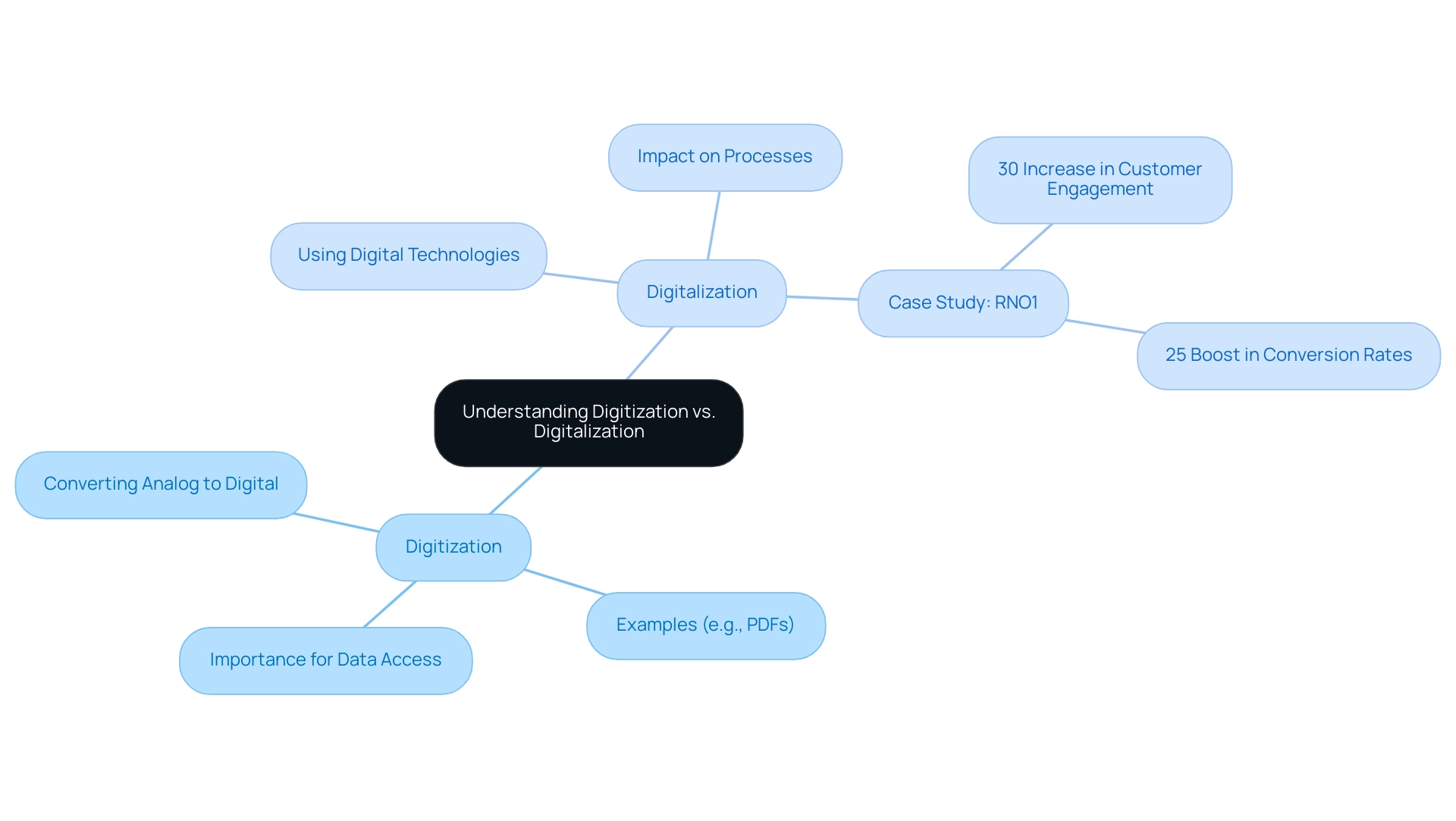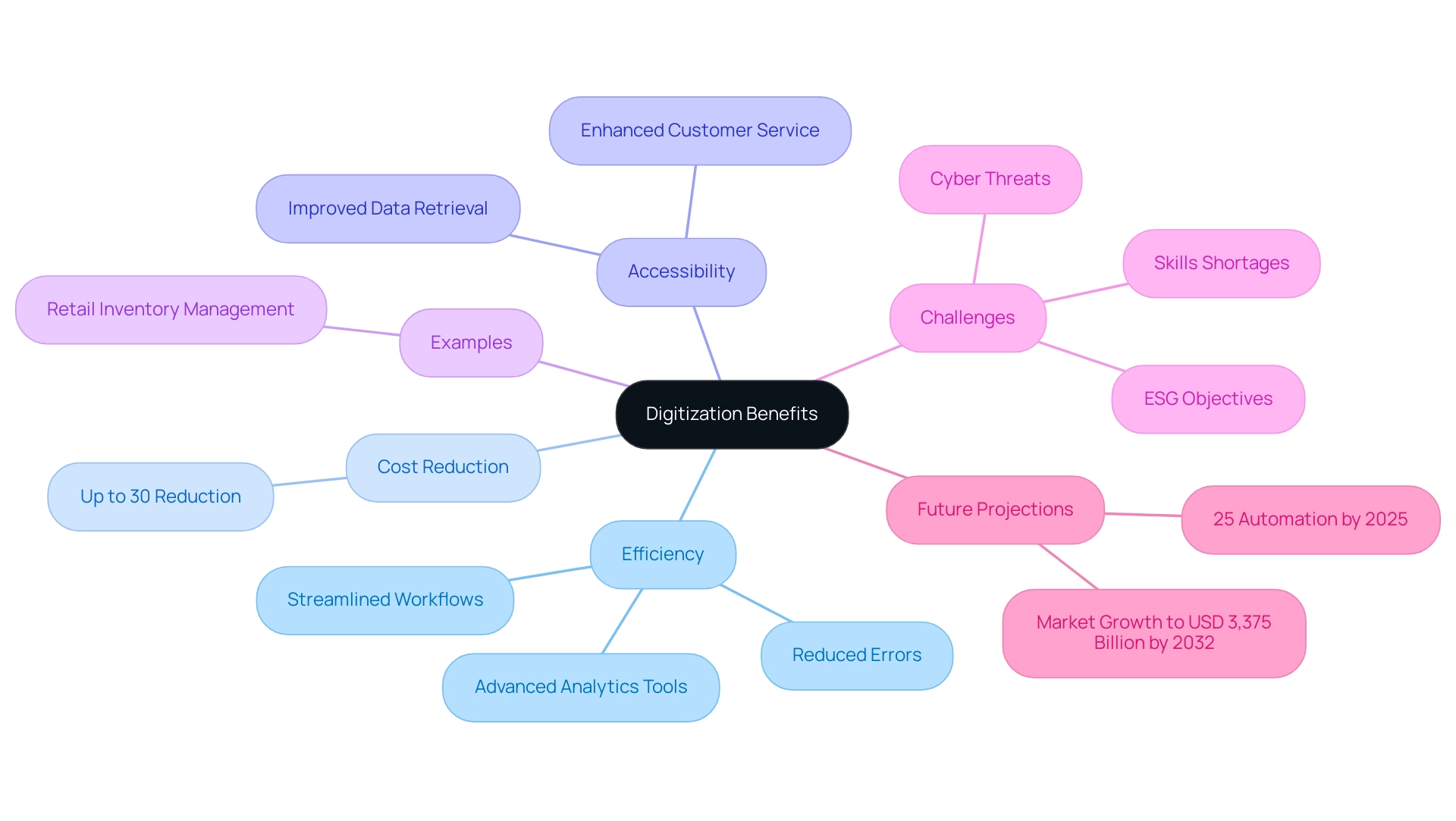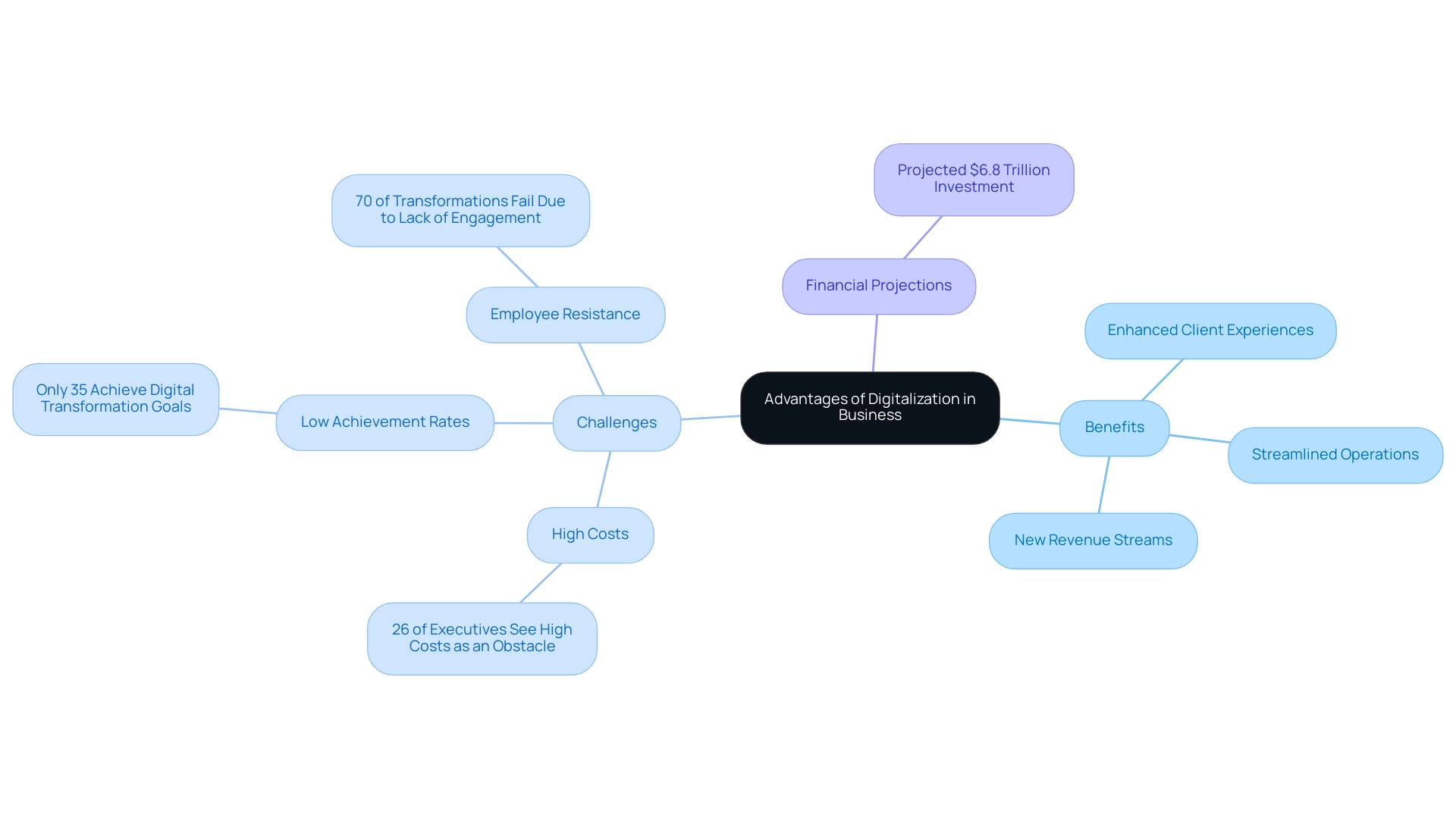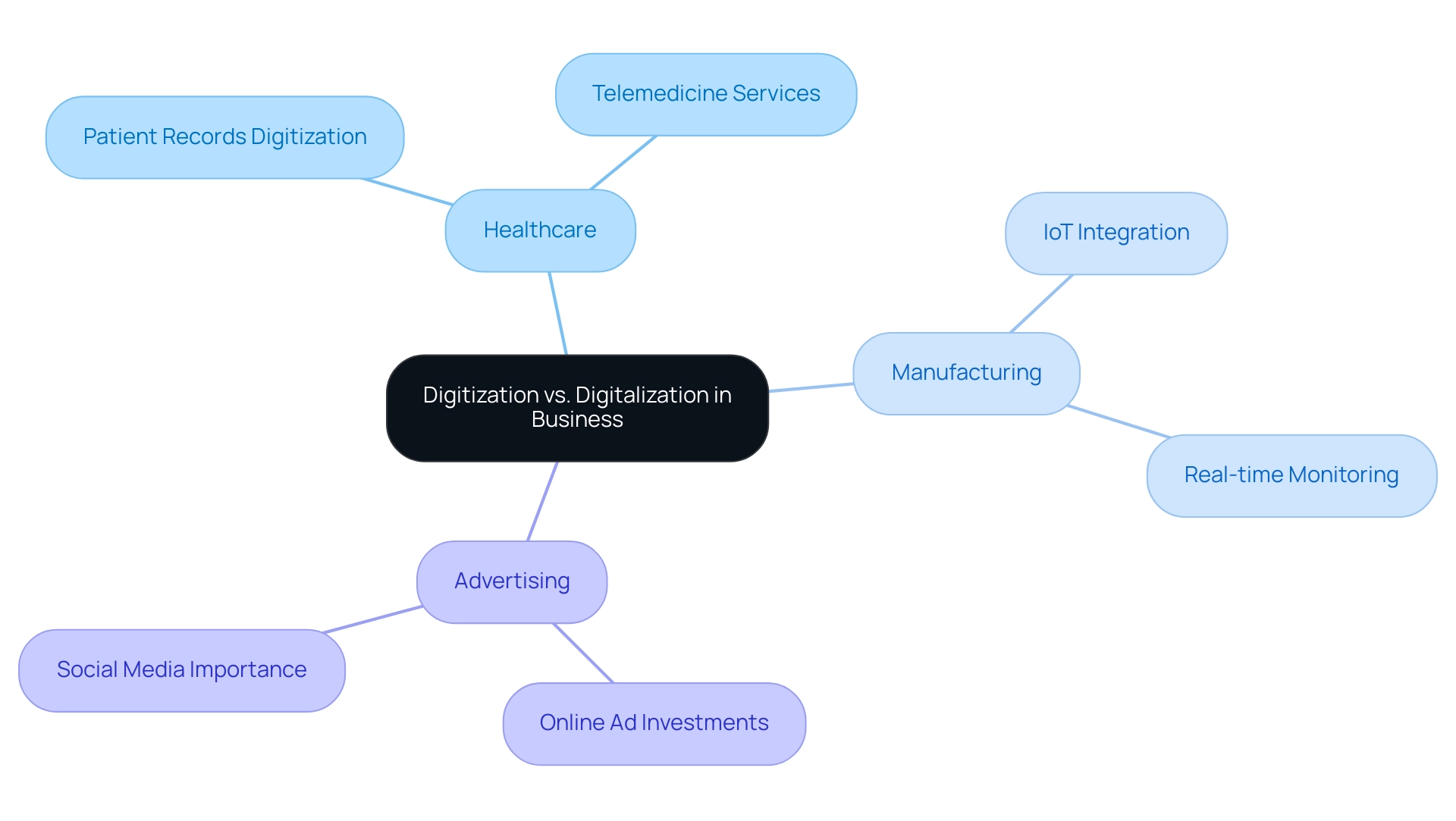Overview
In today’s fast-paced digital world, many businesses grapple with the concepts of digitalization and digitization. This confusion can be a significant hurdle, as digitization is about converting analog information into digital formats, while digitalization refers to using that digitized data to transform and enhance organizational processes. It’s crucial for businesses to recognize these differences because they directly impact how effectively they can implement technological strategies. Failing to understand this can lead to missed opportunities for efficiency, customer engagement, and sustainable growth.
Imagine a tech startup founder, overwhelmed by the rapid changes in technology, unsure about how to leverage digital tools effectively. This uncertainty can lead to frustration and a sense of being left behind in an increasingly digital landscape. However, by grasping the nuances of these concepts, businesses can turn this challenge into a powerful opportunity.
At RNO1, we believe that understanding these distinctions is not just beneficial; it’s essential. We are here to guide you through this journey, helping you harness the power of digitization to drive your business forward. Together, we can navigate the complexities of the digital age, ensuring that you not only keep pace but thrive in this dynamic environment. Let’s embark on this transformative journey, empowering your organization to embrace change and achieve lasting success.
Introduction
In today’s fast-paced business landscape, many organizations find themselves grappling with the terms digitization and digitalization, often using them interchangeably. This can lead to confusion, which is a significant hurdle for businesses striving to thrive in an increasingly digital world.
It’s important to recognize that:
- Digitization refers to the transformation of analog information into digital formats, serving as a crucial foundational step for streamlining operations.
- Digitalization takes this a step further, utilizing these digital assets to enhance processes, enrich customer experiences, and foster innovation.
As we approach the complexities of 2025, it becomes essential for companies to grasp these concepts to harness technology effectively and maintain a competitive edge.
With the surge in online consumer engagement and the pressing need for businesses to adapt to evolving consumer behaviors, the integration of digitization and digitalization is more vital than ever.
This article will explore the nuances of these processes, their benefits, and the challenges organizations encounter as they embark on their digital transformation journeys. Together, we can navigate this landscape and emerge stronger.
Defining Digitization and Digitalization: Key Concepts for Businesses
Digitization is the process of converting analog information into an electronic format, such as transforming paper documents into PDFs. This foundational step is crucial because it allows data to be stored, accessed, and processed electronically, paving the way for more advanced technological applications. However, many tech startup founders struggle to differentiate between digitalization and digitization, which refers to using digital technologies to enhance and transform organizational processes and workflows.
Consider this: a company may leverage digitized customer data to automate its marketing strategies, thus improving operational efficiency and customer engagement. Yet, in 2025, understanding these distinctions is essential for organizations, particularly for founders who aim to harness technology effectively. With RNO1's strategic rebranding of Founder's Haven, the focus is on empowering contemporary founders to achieve success online through effective marketing strategies and innovative approaches. As consumer behavior shifts—evidenced by half of all adult users visiting social platforms to learn about brands—companies must adapt their strategies accordingly.
It's important to note that only 6.7 percent of adult social media users in Russia follow at least one influencer or expert, highlighting varying engagement levels across different markets. The rise of mobile internet access, which has witnessed a decline in traditional desktop usage to 61.5% as of Q3 2024, emphasizes the necessity for enterprises to embrace digital solutions that cater to evolving consumer preferences.
Current statistics reveal that global online consumer goods revenues surged by over half a trillion dollars in 2024, reaching more than US$4.12 trillion, with 2.5 billion people making online purchases. This growth underscores the critical role of understanding digitalization versus digitization in modern business operations. Successful examples abound, where companies have effectively digitized their processes to streamline operations and improve client experiences.
For instance, in the Founder's Haven case study, RNO1 implemented targeted performance marketing strategies that resulted in a 30% increase in customer engagement and a 25% boost in conversion rates within six months of the rebranding. Industry leaders emphasize the importance of grasping the differences between digitalization and digitization. As Leigh Ann Tucker observed, "RNO1's capability to transform branding strategies and enhance marketing effectiveness illustrates the impact of embracing technological transformation."
By comprehending and executing digitization and digitalization, companies can position themselves for sustainable growth and a competitive edge in an increasingly online environment. Together, we can navigate these changes and foster a supportive community for tech startup founders.

The Benefits of Digitization: Enhancing Efficiency and Accessibility
In today’s fast-paced world, organizations often grapple with inefficiencies that can hinder their growth and success. The challenge of managing physical documents and the risk of manual errors can weigh heavily on teams, making it difficult to provide exceptional service to customers. However, digitization offers a nurturing solution that enhances efficiency, lowers operational costs, and improves data accessibility. By converting physical documents into digital formats, organizations can streamline workflows, reduce errors, and facilitate swift data retrieval. For instance, consider a retail company that embraces digitized inventory management; they can instantly access stock levels, which not only improves decision-making but also elevates the customer service experience, fostering a stronger connection with their clientele.
Moreover, digitization opens the door to advanced analytics tools, empowering organizations to extract actionable insights from their data. This capability is essential in a competitive landscape where data-driven decisions can lead to meaningful operational improvements. Studies show that organizations embracing these technologies can achieve up to a 30% reduction in operational costs, a significant relief for those striving to stay afloat in challenging times.
As we look towards the complexities of 2025, the advantages of digitization become increasingly evident. Leaders across various sectors are recognizing that the conversation around digitalization versus digitization is not just a fleeting trend but a fundamental shift that enhances accessibility and operational efficiency. Notably, McKinsey forecasts that 25% of the insurance sector will be automated by 2025, thanks to AI and machine learning methods, highlighting the transformative impact of digitization.
Yet, it’s important to acknowledge that organizations face substantial hurdles in their technological advancement journeys. Cyber threats, ESG objectives, and skills shortages can create significant roadblocks. In the financial sector, for instance, three-quarters of banks and credit unions have initiated transformation efforts, illustrating the urgency and relevance of modernization. Furthermore, the global transformation market is projected to reach USD 3,375 billion by 2032, underscoring the growth and importance of embracing change in the commercial landscape.
This evolution serves as a gentle reminder for enterprises to adapt and innovate, ensuring they remain competitive in a constantly changing online environment. As we navigate these challenges together, it's crucial to support one another, fostering a sense of community and resilience among tech startup founders.

Unlocking Potential: The Advantages of Digitalization in Business
When we think about the differences between digitalization and digitization, it becomes evident that digitalization brings a wealth of benefits for businesses. It significantly enhances client experiences, streamlines operations, and opens up new revenue streams. By embracing electronic technologies, organizations can automate workflows, tailor client interactions, and swiftly adapt to the ever-changing market demands. For instance, consider a financial services firm that fully embraces digitalization; it can leverage AI-driven platforms to provide personalized financial advice, resulting in notable improvements in customer satisfaction and loyalty.
As we approach 2025, the benefits of digitalization are more apparent than ever. Many companies investing in online initiatives are expected to see substantial financial gains, with global investments in technological evolution projected to reach $6.8 trillion from 2020 to 2023. Yet, it’s essential to recognize that 26% of senior executives perceive high costs as a major hurdle to technological transformation. Furthermore, only 35% of enterprises report achieving their technological transformation goals, as highlighted by BCG. This underscores the importance of building robust technological capabilities to drive organizational success while also acknowledging the challenges that many face.
Moreover, transformation fosters continuous innovation, enabling companies to stay ahead in a competitive landscape. Organizations that effectively implement technological strategies can create new revenue streams, as demonstrated by numerous case studies of companies that have successfully transitioned to online models. For example, eCommerce businesses have harnessed online tools to enhance client interactions and increase sales, illustrating the tangible benefits of a technology-first approach.
However, it’s crucial to understand that around 70% of technological changes fail due to a lack of employee engagement and resistance during implementation. Organizations often grapple with challenges such as reluctance to change, integration of legacy systems, and cybersecurity concerns, which can hinder their transformation efforts. Experts emphasize that grasping the nuances of digitalization versus digitization is vital for improving user experiences.
Industry leaders stress that the ability to personalize interactions and streamline services through online methods not only boosts customer satisfaction but also nurtures long-term loyalty. As companies navigate the complexities of the technological era, embracing technological transformation is essential for achieving sustainable growth and maintaining a competitive edge. Together, we can foster an environment where innovation thrives and businesses flourish.

Digitization vs Digitalization: Key Differences Explained
In today's fast-paced business landscape, many founders often find themselves grappling with the terms digitalization and digitization, which, while used interchangeably, serve distinct purposes. Digitization is the initial step—transforming analog information into digital formats, a process that typically happens once. For example, consider a company that digitizes its customer records, converting physical files into electronic documents. This step is essential, yet it's limited to data conversion.
On the other hand, digitalization represents a continuous journey. It involves rethinking and redesigning processes to fully harness the potential of the newly digitized data. This means creating new strategies and workflows that effectively utilize electronic information. For instance, after a company digitizes its client records, it must then digitalize its service operations to leverage that data for personalized marketing efforts. This transition is vital, as it empowers firms to enhance client interaction and improve service delivery.
Understanding the nuances between digitalization and digitization is crucial for businesses aiming to implement effective online strategies. A recent study reveals that 71% of clients are more likely to trust a company with their personal data if its usage is clearly communicated. This statistic underscores the importance of transparency in digital initiatives, especially as organizations navigate the complexities of client expectations and ethical considerations surrounding data usage.
However, many organizations face challenges during their digital transformation journeys. Often, they rush into the process without adequately assessing client needs. This oversight can lead to significant pitfalls, highlighting the necessity of prioritizing customer understanding and trust-building through clear communication about data usage and AI applications. Successful digital change requires clear objectives, strong communication, and effective leadership to help enterprises navigate these challenges.
By recognizing the differences between digitalization and digitization and understanding the essential elements of technological evolution, organizations can better equip themselves for success in an increasingly digital world. Remember, this journey is not just about technology; it's about fostering relationships and building trust with your clients.
Digital Transformation: The Next Step Beyond Digitization and Digitalization
Digital evolution can feel overwhelming for many organizations, as it represents a significant shift in operations. The concepts of digitalization and digitization can often lead to confusion, leaving leaders wondering how to enhance performance and deliver greater value to their clients. This transformation calls for a deep reassessment of existing models, processes, and interactions through the lens of technology. For instance, a traditional retail shop might begin its journey by embracing eCommerce platforms, harnessing data analysis for smarter inventory management, and enhancing customer interactions through personalized marketing strategies.
As we approach 2025, more companies are recognizing the importance of this technological transformation. Statistics reveal that 67% of organizations are now adopting automation solutions to gain better visibility across their systems. However, this shift is not merely about integrating new technologies; it’s about fundamentally reshaping how businesses operate and the value they provide to those they serve. RNO1, a dedicated global branding and growth agency, is here to guide companies through this transition with innovative solutions tailored for eCommerce and technology.
RNO1 offers a range of services—including online strategy, UX & UI design, performance marketing, and SEO strategy & systems—that enhance operational efficiency and foster meaningful customer engagement. These services are designed to drive rapid ROI for brands, ensuring they not only survive but thrive in a competitive landscape.
Consider the story of Cirkul, one of RNO1's valued clients. They successfully scaled their eCommerce capabilities through integrated online campaigns that not only connected with audiences but also nurtured brand loyalty. This approach resulted in a remarkable 150% revenue increase within just six months, showcasing how RNO1's tailored strategies empower brands in the bustling eCommerce environment.
Industry leaders emphasize that technological change transcends the basic concepts of digitalization and digitization. It builds upon these ideas to foster a more agile and responsive operational model. As Ori Herrmann, a Content & Creative Manager, points out, organizations embracing technological transformation are achieving extraordinary results—such as 90% AI-competent workforces and an 85% return on investment on AI initiatives.
RNO1's expertise in branding and online design, along with their effective SEO strategies, can empower businesses to realize these outcomes by leveraging advanced technologies and innovative approaches.
Ultimately, the integration of eCommerce and data analytics is crucial for businesses aiming to flourish in the online landscape of 2025. By embracing these tools, companies can streamline their operations and create personalized experiences that truly resonate with customers. This not only ensures sustained growth but also establishes a competitive advantage in an ever-evolving market. RNO1 is ready to support brands in this journey, providing the expertise and resources necessary for successful transformation.
Real-World Applications: How Businesses Are Leveraging Digitization and Digitalization
In today’s rapidly evolving landscape, many organizations across various industries are grappling with the complexities of digitalization versus digitization. This challenge is particularly evident in the healthcare sector, where the digitization of patient records has not only streamlined administrative workflows but also reduced errors and improved overall efficiency. This essential step lays the groundwork for understanding the nuanced differences between digitalization and digitization, including the implementation of telemedicine services, which expands patient access to care and facilitates remote consultations.
In the manufacturing sector, companies are turning to Internet of Things (IoT) devices to digitize production data. This integration offers the opportunity for real-time monitoring of manufacturing processes, empowering organizations to optimize their operations and swiftly address inefficiencies. A compelling case study from 2025 illustrates this point, showcasing a manufacturing firm that leveraged IoT technology to reduce downtime by an impressive 30%. This example highlights the tangible benefits of digitization in enhancing productivity and fostering a more efficient workplace.
Moreover, the global advertising landscape is undergoing a significant transformation, with online channels now representing 72.7% of total ad investments. This shift reflects a broader trend towards electronic solutions across various sectors. However, research from BCG reveals a troubling statistic: 70% of technological transformations fail due to insufficient employee involvement and resistance during the implementation process. This underscores the challenges organizations face in their digitization efforts. Additionally, it’s noteworthy that half of all adult users turn to social platforms to learn more about brands, emphasizing the critical importance of establishing a robust online presence in the context of digitization.
As we navigate these evolving digital waters together, it becomes clear that the successful application of digitalization versus digitization is vital for driving innovation and maintaining a competitive advantage. By embracing these changes with empathy and understanding, organizations can foster a culture of collaboration and growth, ultimately leading to a brighter future for all involved.

Navigating Challenges: Overcoming Obstacles in Digitization and Digitalization
Organizations often grapple with significant hurdles during the implementation of digitalization versus digitization, despite the substantial advantages these processes can bring. The problem is real: resistance to change, insufficient technology infrastructure, and a shortage of skilled personnel can create a daunting landscape. It’s concerning to note that 44% of organizations express apprehension about the need to establish a dedicated team to drive their transformation efforts, as highlighted by Infosys. This statistic serves as a reminder of the importance of directly addressing these challenges.
The urgency for businesses to adapt is underscored by the dramatic rise in advertising expenditure on online platforms since the outbreak of Covid-19, which continues to draw share from offline channels. As we reflect on these changes, it becomes clear that cultivating a culture of innovation and adaptability is essential. Investing in comprehensive employee training and ensuring robust technological support can pave the way for smoother transitions. Implementing change management strategies can be particularly effective in alleviating employee concerns regarding new technologies.
By fostering open communication and clearly articulating the benefits of technological initiatives, organizations can nurture greater acceptance among their teams. Consider the shift in desktop usage: as of Q3 2024, only 61.5% of online adults were using laptops and desktops, a decrease from 72.3% in Q1 2020. This change illustrates the necessity for marketers to evolve their strategies to meet shifting access patterns, especially in light of the rapid evolution of online platforms like Meta's Threads, which has reached 320 million monthly active users.
Moreover, industry leaders emphasize the importance of addressing resistance to change in online initiatives. By proactively tackling these challenges, businesses can significantly enhance their prospects for successful digitalization versus digitization, ultimately positioning themselves for sustainable growth in an increasingly digital landscape. Together, we can navigate these complexities and foster a supportive environment that encourages innovation and growth.
Conclusion
In today’s fast-paced digital landscape, understanding the differences between digitization and digitalization is essential for businesses striving to thrive. Many organizations face the challenge of digitization, which is the crucial first step of converting analog information into digital formats. This transformation not only enhances accessibility but also boosts operational efficiency. However, the journey doesn’t stop there; digitalization takes these digitized assets and uses them to transform business processes, improve customer experiences, and ignite innovation. As we look toward the complexities of 2025, recognizing and implementing these concepts will be vital for maintaining a competitive edge.
The benefits of both digitization and digitalization are clear across various sectors—think healthcare and manufacturing—where streamlined operations and enhanced service delivery are becoming the norm. Yet, the path to successful digital transformation is not without its challenges. Many organizations encounter resistance to change and struggle to find skilled personnel. By nurturing a culture of innovation and investing in comprehensive training, businesses can overcome these hurdles and truly harness the potential of digital technologies.
Ultimately, embracing digitization and digitalization goes beyond merely adopting new technologies; it requires a fundamental rethinking of business models and customer interactions. As companies navigate this transformative landscape, those who effectively integrate digital strategies will not only enhance their operational capabilities but also create lasting value for their customers. The call to action is clear: prioritize digital transformation to ensure sustainable growth and success in an ever-evolving digital world. Together, let’s embrace this journey and support one another in fostering a brighter, more connected future.
Frequently Asked Questions
What is digitization?
Digitization is the process of converting analog information into an electronic format, such as transforming paper documents into PDFs. This enables data to be stored, accessed, and processed electronically.
How does digitization differ from digitalization?
While digitization refers to converting analog information into digital formats, digitalization involves using digital technologies to enhance and transform organizational processes and workflows.
Why is understanding the difference between digitization and digitalization important for organizations?
Understanding these distinctions is crucial for organizations, particularly founders, as it helps them effectively harness technology to improve operational efficiency and customer engagement.
What impact does digitization have on operational efficiency?
Digitization enhances efficiency by streamlining workflows, reducing errors, and facilitating swift data retrieval, which can lead to improved decision-making and customer service.
What are some benefits of digitization for organizations?
Benefits include enhanced efficiency, lower operational costs, improved data accessibility, and the ability to utilize advanced analytics tools for data-driven decisions.
How has consumer behavior shifted in relation to digital platforms?
As of 2025, half of all adult users visit social platforms to learn about brands, indicating a significant shift in how consumers engage with companies.
What growth has been observed in global online consumer goods revenues?
Global online consumer goods revenues surged by over half a trillion dollars in 2024, reaching more than US$4.12 trillion, with 2.5 billion people making online purchases.
What challenges do organizations face in their technological advancement journeys?
Organizations encounter substantial hurdles such as cyber threats, ESG objectives, and skills shortages that can impede their transformation efforts.
What is the projected growth of the global transformation market?
The global transformation market is projected to reach USD 3,375 billion by 2032, highlighting the importance of embracing change in the commercial landscape.
How can companies position themselves for sustainable growth in an online environment?
By comprehending and executing digitization and digitalization, companies can gain a competitive edge and adapt to evolving consumer preferences, fostering resilience and innovation.




